Evolutionary Bio Exam 2
1/114
There's no tags or description
Looks like no tags are added yet.
Name | Mastery | Learn | Test | Matching | Spaced |
|---|
No study sessions yet.
115 Terms
Allele Frequencies in Hardy-Weinberg are represented by?
p and q
Genotype frequencies in Hardy-Weinberg are represented by?
p² + 2pq + q² = 1
What does H-W equation tell you?
Given a set of observed allele, the H-W equation tells you the expected genotype frequencies
Hardy-Weinberg equilibrium assumptions
Population allel frequencies do not change when: population is infinitely large (no genetic drift), genotypes do not differ in fitness (no selection), there are no new mutations (no new alleles), there is no migration (no new alleles) and mating is random (with respect to genes of interest)
If a population is not in Hardy-Weinberg equilibrium then why? What is causing it to evolve?
Is the population small? Do genotypes differ in fitness? Are there new mutations? Is mating random? Is there significant migration?
A population not in Hardy-Weinberg Equilibrium will reach Hardy-Weinberg genotype frequencies after…
a single round of random mating
In the absence of evolutionary processes…
allele frequencies will remain constant
gene
Unit of heredity that carries instructions for making proteins; segments of DNA located on chromosomes; responsible for determining traits and characteristics in living organisms.
allele
A variant form of a gene that determines a specific trait. Alleles can be dominant or recessive, and individuals inherit two alleles for each gene, one from each parent. Alleles can interact to produce different phenotypes, and variations in alleles contribute to genetic diversity within a population.
locus/loci
The set of all points that satisfy a given condition or property.
phenotype
physical traits
genotype
genetic code for traits
homozygous
two same alleles
heterozygous
two different alleles
Law of Segregation (Mendel’s First Law)
only one of the two gene copies present in an organism is distributed to each gamete that it makes and the allocation of the gene copies is random
Law of Independent Assortment (Mendel’s Second Law)
The alleles of two (or more) different genes get sorted into gametes independently of one another
dominant allele vs. recessive allele
Dominant alleles are shown in the phenotype over the recessive
incomplete dominance
a form of gene interaction in which both alleles of a gene at a locus are partially expressed often resulting in an intermediate or different phenotype (red flower + white flower = pink offspring)
Sex-linked
genotypes are carried on an X or Y chromosome making them more likely to be present in females or only present in males
mitosis
cell division that occus in eukaryotic cells where parent cell divides into two identical daugter cells
meiosis
a type of cell division in sexually reproducing organisms that reduces the number of chromosomes in gametes
crossing over
a cellular process that happens during meiosis when chromosomes of the same type are lined up, occurs during meiosis prophase 1
Haploid individuals carry one allele at every locus where are diploid individuals…
carry two alleles at every locus (homozygous vs. heterozygous)
polyploids
more than two alleles at every locus
evolution
change in allele frequencies from one generation to the next
percentage of coding exons
0.008 (less than one precent)
generation sources of genetic variation
mutation
redistribution sources of genetic variation
recombination, independent assortment, hybridization, horizontal gene transfer
point mutations
one different codon
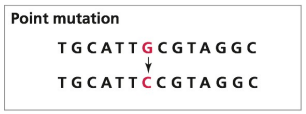
Insertion
a section inserted into existing codons

deletion
section deleted from original strand
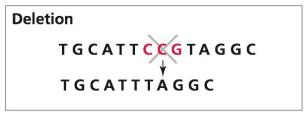
gene duplication
repeat gene section
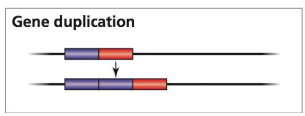
inversion
flipped section of genes

chromosome fusion
chromosomes are fused

genome duplication
completely duplicated genome

Germ-line mutations are
heritable (only germ-line)
somatic mutations
affect cells in the body of an organism (not heritable in most cases, except no separate germ line in single-celled organisms, except totipotency in plants)
germ-line mutations
affect gametes, heritable and relevant to evolution
possible consequences of single point mutations
albino-ism, extra digits, fused digits, hyper-/hypo- pigmentations, misshaped skeleton, large brain
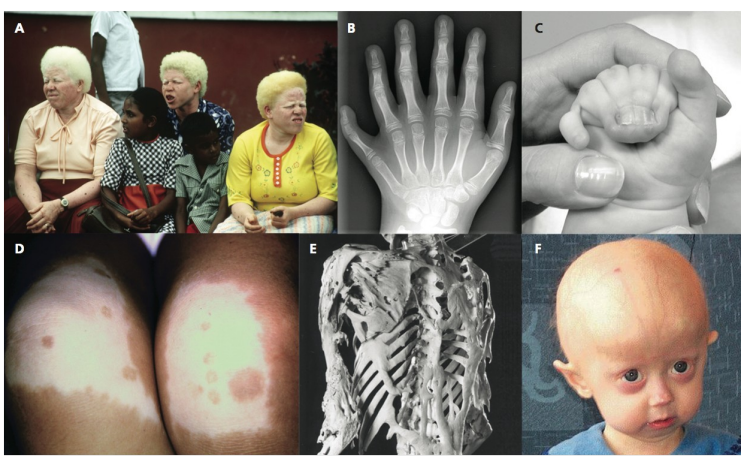
sickle-cell anemia
most common inherited blood disorder in the USA, non-synonymous point mutations in hemogloin beta gene

synonymous vs. nonsynonymous mutations
synonymous mutations are DNA mutations that do no change the amino sequence of a protein (minor) vs. nonsynonymous mutations are nucleotide mutations that change the animo acid sequence of a protein (evolutionary important)
insertions and deletions are important in protein genes when…
not in multiples of 3 and in-frame (outside of protein genes: anything goes)
transposable elements
specific form of genetic recombination that moves transposable elements from one place to another (jumping)
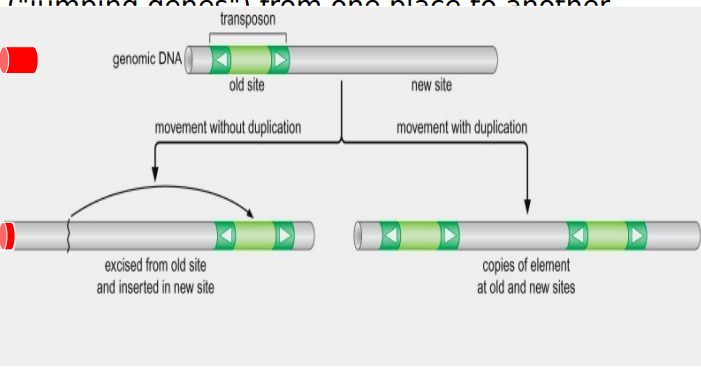
Alu insertions can insert themeselves within genes, implicated in many human diseases. What are examples?
breast cancer, ewing’s sarcoma, familial hypercholesterolemia, hemophilia, neurofibromatosis, disbetes mellitus type II
genomes are dynamic entities
genes are constantly undergoing duplications and loss; genes and genomes are continuously turning over
divergence
when duplication event results in different outcome than redundancy
Susumu Ohno, Evolution by Gene Duplication quote
“natural selection merely modified, while redundancy created”
neofunctionalization
duplicate takes on an entirely new function
sunfunctionalization
the duplicate takes on a specialized role similar and complementary to the ancestral function
Loss
mutational decay or wholesale loss (most common)
most genes do not exist as a ______ within and across species
single copy (most genes are part of larger gene “families”)
Terpene synthases
terpenoids (in resins, essentual oils, and aromas) more than 2-fold increase in number in grapes, directly related to aromatic features of wine
examples of gene families and number of copies per
actins (5-30), tubulins (5-15), histones (100-1000), immunoglobin (more than 500), heat-shock proteins (3-5)
ploidy
number of copies of unique chromosomes in a cell
polyploidy can result in
instantaneous sympatric speciation
diploid X tretraploid results in
sterile triploid (seedless fruits)
gemone duplications
whole-gemone duplications are important driver of evolution in several diverse lineages, gene duplication on a grand scale
What percent of all speciation events in flowering plants involve whole-genome duplications?
15% (all flowering plants are ancient polyploids)
independent assortment
creates novel combinations of alleles, alleles of different genes assort independently of one another (as long as they’re not linked)
recomination reshuffles chromosomes, where and when does this occur?
germ-line, meiosis: prophase I
genetic linkage
the physical proximity of alleles at different loci, loci that are physically close are less likely to be separated by recomination during meiosis, they are said to be genetically “linked”
linkage equilibrium
alleles at one locus segregate randomly with respect to alleles at the other
linkage disequilibrium
alleles at different loci are nonrandomly associated, they are segreating together more often than expected by change
bottom line of genetic linkage?
recomination is an important source of genetic variation
evolution is _______ in allele frequencies from one generation to the next
change
evolution does not occur under what kind of conditions?
hardy-weinberg
how do populations evolve?
genetic drift, natural selection, migration (gene flow), mutation
when are sampling errors higher?
smaller sample sizes
evolution by drift
reduces genetic variation in small populations, more dramatic fluctuations in small populations, alternative alleles become fixed, less overall standing variation in small populations
in a finite population allele frequencies fluctuate…
overtime, even in the absence of natural selection
random, nonrepresentative allele (gamete) sampling…
leads to changes in allele frequencies
what is the primary cause of random allele sampling?
meiosis
why is each reproductive event an “independent role of the dice”?
independent assortment and recominations
why do individuals only pass on some (not all) of their alleles?
they only reproduce a finite number of times (some don’t reproduce at all)
some alleles are fixed and others are lost causing
a decreasing fraction of heterozygotes over time
functionally deleterious alleles can become fixed…
in a population by genetic drift
what is a result of genetic drift?
seperate populations diverge in allele frequencies and presence/absence of certain alleles
genetic drift is _____ in small populations
the predominant evolutionary mechanism
bottlenecks
reduce genetic variation
what happens to rare alleles during a bottleneck?
they are likely to be lost
northern elephant seals
hunted and nearly extinct in 1800s, “last” 8 were found in 1892 and killed to be in a museum, now 100,000 exist
bottleneck significance of northern elephant seals
post-bottleneck very little detectable heterozygosity, more found in pre-bottleneck specimens
cheetahs bottleneck significance
very little genetic heterozygosity, no polymorphic loci, similar to lab-bred mice
pingelapese islanders
high incidence of complete color blindness
founder effects cause genetic drift
new popilations started by a small number of individuals
american amish populations
2 waves of immigrations: 500 german immigrants in the 1700s, 3000 german immigrant in the early 1800s
Ellis-van Creveld syndrome
genetic disorder with autosomal recessive transmission
key concept for bottlenecks
even brief bottlenecks can lead to a drastic reduction in genetic diveristy that can persist for generations
fitness
the reproductive success of an individual with a particular phenotype
components of fitness
survival to reproductive age, mating success, fecundity (number of offspring produced)
relative fitness
fitness of a genotype standardized by comparison to other genotypes
average excess fitness
difference in fitness between average fitness of individuals with a given allele vs. the average fitness of the population as a whole
this equation describes the change in allele frequency due to selection
p(o) > 0 if allele is present at all, effectiveness of selection is directly porportional to the frequency of the allele
delta p is greater than 0: allele increase in frequency, delta p is less than 0 < allele decreases in frequency
w > 0 if population exists
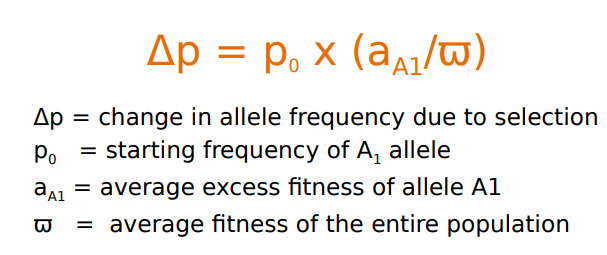
natural selection is more powerful in large populations
drift weaker in large populations, small advantages in fitness can lead to large changes over the long term
the strength of selection influences…
how quickly a trait will increase in frequency within a populations over time
selection occurs when genotypes differ in…
fitness
what do outcomes of selection depend on?
frequency of allele of effects on fitness
population size influences power of drift and selection
drift more powerful in small populations and selection more powerful in large populations
additive
allele yields twice the phenotypic effect on two copies present
dominance
dominate allele masks presence of recessive in heterozygotes